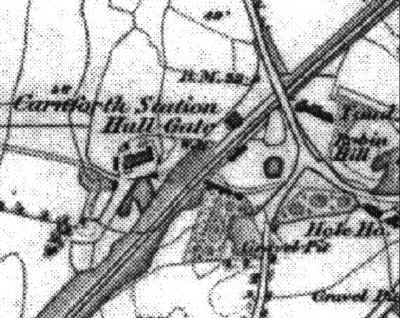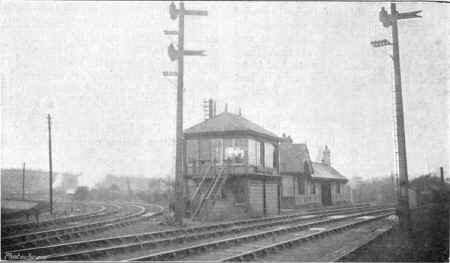The Development
of
Carnforth
Railway Station. Work
started on the Lancaster and Carlisle Railway at Bolton Le Sands in
September 1844, and the first permanent rail was laid at Carnforth in
December 1844, by S.B.Worthington. 22nd
September 1846, the Lancaster Castle to Oxenholme line was opened by
the Lancaster and Carlisle Railway Co. There has
been a lot of debate about the exact position of the original Carnforth
Station. The Ordnance Survey 6 inch map (First edition), Lancashire
Sheet 24, surveyed in 1845/6 and published in 1848 shows the Station as
being in its current position, just to the South of the Warton Road
Bridge. 
Extract from Map by courtesy of
Ordnance Survey. |
This location is further confirmed
in the 1848 Lancaster and Carlisle Railway, Time and Fare table where
Carnforth is given as being 2.5 miles north of Bolton (le Sands)
Station. There is much uncertainty about the
original name for Carnforth station. Harold Bowtell calls the early
station "Carnforth Hall Gate". This was probably because of the map
above.
"Hall Gate" was actually the farm, whose buildings
(long since demolished) could be seen under the word "Hall". Later maps
separate the words,"Carnforth Station" and "Hall Gate" to make it
clearer. Reputedly, Carnforth was soon called
"Carnforth-Yealand" or possibly "Carnforth for
Yealand". Yealand having a small halt, a short distance to the north of
Carnforth Station. This small halt was only used on market days, at
other times passengers for Yealand would have to use Carnforth station.
Yealand halt didn't last long. Carnforth, Yealand can be
seen on the 1848 Lancaster and Carlisle Timetable, but this may have
been because Carnforth station and Yealand Halt were reasonably close,
and the time given, was intended as being the time for both stations.
It is probable, that the building used in later years, as the
refreshment room, on Carnforth station, was the original 1846 station
building, designed by Sir William Tite. A dark square on the 1845 map
is in the correct position, and this building is of the same style as
other buildings built at the same time on the Lancaster and Carlisle
Railway. When built, Carnforth station was a
"second class" roadside station, with a building to the west of the
line. There may have been a platform on the south bound line, but this
would have only been a simple wooden platform. In
the 1850's the Furness Railway had lines as far as Ulverston, but the
vital rail link to London was missing.
The "Ulverstone and
Lancaster Railway" was formed, and built a line from Ulverston to
Carnforth, where in August 1857, it joined the lines of the Lancaster
and Carlisle Railway. The junction between the Ulverston and Lancaster,
and the Lancaster and Carlisle Railways was some distance to the south
of Carnforth station. This may have been because of the limited
visibility to the north of Carnforth station. Having the junction
further to the south, allowed the signal/points man a much better view
of approaching trains, from both the north and the south. A
small engine shed was built to the east of the
Ulverston and Lancaster line, just outside Carnforth station. Access to
the station was from Warton Road. Carnforth now had two or
three platforms and had grown from a roadside, to a junction station.
April 1867 The line opens between Carnforth and Wennington
When the
Carnforth - Wennington line was first opened, a temporary station was
built, close to what eventually became "East Junction".

The first Carnforth
Furness and Midland station,
close to what was
later to become "East Junction".
This photograph (Railway
Magazine 1904)
Shows the station some 35 years after
closure. |
This temporary station was only in
use for about a year, until a more permanent station was built close to
Hagg Farm, and where a bridge crossed the river Keer. This second
Carnforth Furness and Midland station was in use between 1868 and
1880. Carnforth Lancaster and Carlisle
and Furness Railway joint station, developed into quite a large
junction station, and by 1870 many of the current buildings, on the
centre island platform were probably in place.

Carnforth station, circa 1870 |
The
small building, on the right hand platform, behind the lamp-post is the
Post Office. The eastern direct link between the
Wennington line, and the main station wasn't built until circa 1880.
The original Furness Railway depot having to be demolished, and
re-built on the site of the current "Steamtown" site. 1880
A large new Station was completed at Carnforth, at a cost of �40,000 .
The South bound main line platform had been roofed over, and a ticket
office, passengers waiting rooms and a parcel's office had been built.
Carnforth station stayed very much
in its 1880 form until 1938, when the London Midland and Scottish
Railway, took advantage of Government grants, and rebuilt the station,
knocking down the overall roof over the Furness platform, and adding a
new down Furness platform. This was the form the
station was to remain in, until the post 1968 decay.
[
Top ] [ Home ] |